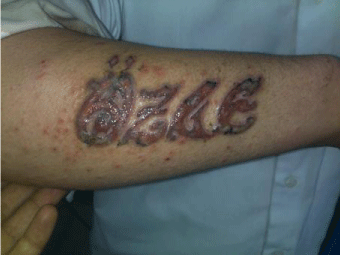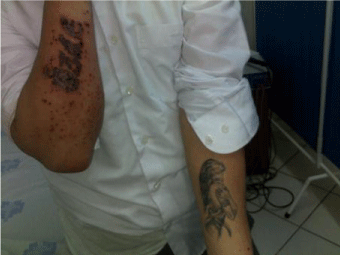
Special Article - Dermatology Clinical Cases and Images
Austin J Dermatolog. 2015; 2(2): 1037.
Tattoo Associated Allergic Contact Dermatitis
Dikicier BS*, Yaldız M, Çetinkaya R and Erdem T
Department of Dermatology, Sakarya University Medical School, Turkey
*Corresponding author: Bahar Sevimli Dikicier, Department of Dermatology, Sakarya University Medical School, Turkey
Received: October 29, 2015; Accepted: November 06, 2015; Published: November 09, 2015
Introduction
The term tattoo describes the deliberate placement of permanent colors into the skin or the accidental entry of pigmented material [1]. Allergic contact dermatitis (ACD) is a delayedtype of induced sensitivity (allergy) resulting from cutaneous contact with a specific allerge into which the patient has developed a specific sensitivity. This allergic reaction causes inflammation of the skin manifested by varying degrees of erythema, edema, and vesiculation. We report a case of tattoo associated allergic contact dermatitis due to specific pigment materials, green and white.
Case Presentation
A 17-year-old boy presented with a severely pruritic, erythematous, oozyreaction in the location of a tattoo on his right arm. He had placed the tattoo 3 weeks ago and told that it had been discharging fluid for one week. Severe edema, causing the tattoo appear like a total bullous lesion was observed (Figure1). Some erythematous and crusted papules were also presenton his arm distant from the tattoo site and on his abdomen. He refused to have a biopsy from the reaction site. He had another tattoo on his left arm, he told that it was placed at the same time; but no reaction was present on this one (Figure 2). Both tattoos were permanently made, the difference was the pigment types: permanent green and white coloured tattoo turned to a pruritic wound while the black colored tattoo remained intact on the other arm. Systemic and topical corticostreoids and antihistamine was started , but the reaction never cleared totally (Figure 1). Patient had decided to have a laser tattoo removal and lost follow-up.

Figure 1: Acute allergic reaction on the tattoo site.

Figure 2: Allergic contact dermatitis on the right arm tattoo containing green
and white pigment materials, while there is no reaction on the left arm tattoo
containing just black pigment.
Discussion
Complications resulting from decorative tattoos are relatively rare considering the popularity of tattooing; however, the introduction of foreign substances into the skin can result in a toxicorimmunologic response. In addition to the transmission of infectious disease, reactions to tattoo pigments have also been described. These reactions include acute inflammatory reaction; allergic hypersensitivity; and granulomatous, lichenoid, and pseudolymphomatous types of histopathologic reactions [1].
Pigments are composed of both salts and inorganic metals such as mercury (red), chrome (green), manganese (purple), cobalt (blue), cadmium (yellow) and hydrate dironoxide (ochre) and of organic preparations such as sandalwood (red) and brazilwood (red) have been associated with various dermatoses [2].
In contrast to hypersensitivity reactions tored tattoos, reaction stopigmentsused to create green, blue, and black tattoos are much less common. Chromium in green tattoo pigment is associated with localized eczematous reactions at the site of the pigment, eczema of the hands, and generalized eczematous reactions. Patients may be sensitized primarily by exposure to cement. Patch testing to 0.5% potassium dichromate is often positive. Previously quiescent green-colored tattoos may become inflamed during patch testing in potassium dichromate–sensitive individuals [3]. Allergic reactions to black tattoo pigment are very rare, with fewer than 5 cases reported. Presumably, the patients were sensitive to carbon [4].
We did not performed patch testing for this patient, since there action never totally cleared and so the patient had to be on medication for a long time. This case is an impressive example of allergic contact dermatitis due to certain tattoo pigment types. One should never be sure about the risk of allergic reaction of a particular tattoo, because the allergic potential changes according to pigment material. This is a demonstrative case of generalized all ergic contact dermatitis associated to certain pigment types: green and white colored tattoo became even invisible due to severe acute allergic contact dermatitis whereas the other tattoo, black colored one remained intact on the arm.
References
- Bhawan J, Parija G. Tattoo reactions. J Cutan Pathol. 1978; 5: 314-315.
- Cruz FAM, Frigerio RF, Arruda LHF, Lage D, Zaniboni MC. Reactions to the different pigments in tattoos: a report of two cases.An Bras Dermatol. 2010; 84: 708-711.
- Jacob SE, Castanedo-Tardan MP, Blyumin ML. Inflammation in green (chromium) tattoos during patch testing. Dermatitis. Sep-Oct. 2008; 19: E33-34.
- Gallo R, Parodi A, Cozzani E, Guarrera M. Allergic reaction to India ink in a black tattoo. Contact Dermatitis. Jun 1998; 38: 346-347.